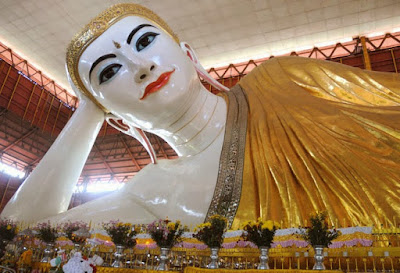Elizabeth J. Harris, A Journey into Buddhism (2005) edited by Wisdom Quarterly; Javedan TV
 |
| Our flag used to stand for everything good. |
I helped plan their program and was also asked to prepare a few talks for the World Service's daily "Words of Faith" spot....
The themes of the talks are rooted in my journey, as a Christian, into Buddhism.
In the mid-1980's I felt the need to "let go" of my own religious-conditioning to enter the world of another spiritual tradition. It grew from a conviction that people with an interest in religion should not remain imprisoned within one framework but should explore others.
 |
| Universal rainbow Buddhist flag |
I originally intended to be in Sri Lanka for one year. One year, however, became seven and a half. My aim throughout was not only to study Buddhism but to practice it. I did not consider myself involved in an "interfaith dialogue" although I'm sure some perceived my actions in this way.
I wanted to enter Buddhism on its own terms, as a human being rather than as a Christian. The subjects of all the talks printed here arise from the personal journey of discovery that resulted.
 |
| The Buddha and Jesus (bizarro.com) |
Most importantly, they reflect the concerns that developed as the interests I brought from Britain encountered Buddhism and Sri Lanka:
- the relationship between non-attachment and outgoing compassionate action;
- the practical meaning of anatta (no soul, not self, egolessness) and its implications;
- the benefit of sati (mindfulness practice) for the individual and society;
- the resources Buddhism can offer those working for social justice and inter-ethnic or inter-religious harmony;
- the question of a woman's role in society.
I remain a Christian, one who seeks to follow the self-sacrificial path of Jesus of Nazareth, but I also feel quite at home in a Buddhist meditation center.
These talks, I hope, will show that this is possible. I dedicate them to all the Sri Lankan friends who have brought me to a deeper understanding of the heart of Buddhism.
-Elizabeth Harris, June 1994
1. What is Mindfulness?
 |
| The Buddha reclines into final nirvana between two sal trees, his skin all golden. |
.
 |
| FREE Buddhist Dictionary |
In the Theravada Buddhist tradition -- still found in Burma, Sri Lanka, Thailand, Cambodia, and Laos -- the practice of mindfulness or "bare attention" is very important. When sitting in meditation, perhaps aware of the breath as it touches the rim of the nostrils, thoughts inevitably enter the mind.
Usually these thoughts relate to oneself in the past or the future. Recent conversations replay themselves. Decisions yet to be made thrust themselves forward. Reactions of dislike to bodily pains arise. And occasionally, images freed from a deeper level of our being move slowly upwards.
 |
| Meditation's an internal process not a pose. |
When I first began to meditate I discovered that thoughts and feelings are fluid, ever changing, often uncontrollable, frequently illogical and irrational. It was a painful realization, since I had assumed my mind was under my direct control. But it was also the beginning of self-knowledge, the beginning of knowing how my mind worked and the doorway to modifying conditioned and negative patterns of reaction in my own life.
At one meditation center in Sri Lanka, high up in the mountains surrounded by tea estates, the first session begins at 5:00 in the morning. I had to get up by candlelight, pull on warm clothes, and cross the grass to the meditation hall, under a sky often brilliantly full of stars. One morning, I was gazing at the dark, silvered beauty of the sky when I heard steps below me. At that moment, I caught my mind saying, "Go on into the meditation hall so that they can see you were up first."
 |
| Now I can sit keeping "mind" in perspective. |
And I know it was the practice of sati, of mindfulness, which made that moment of insight into my own competitive egotism possible, insight into a childish wish to impress, to be top of the class.
Meditation of this kind is hard work. It has nothing to do with making the mind a blank, though it can lead to peace and calm when the racing mind stills and there is only the present moment. One monk who taught me put it this way: "Meditation is the ultimate practice of non-violence. Suffering, pain, and feelings of anger are not suppressed but faced, confronted, and transformed." TO BE CONTINUED More

















































































































































































































































No comments:
Post a Comment